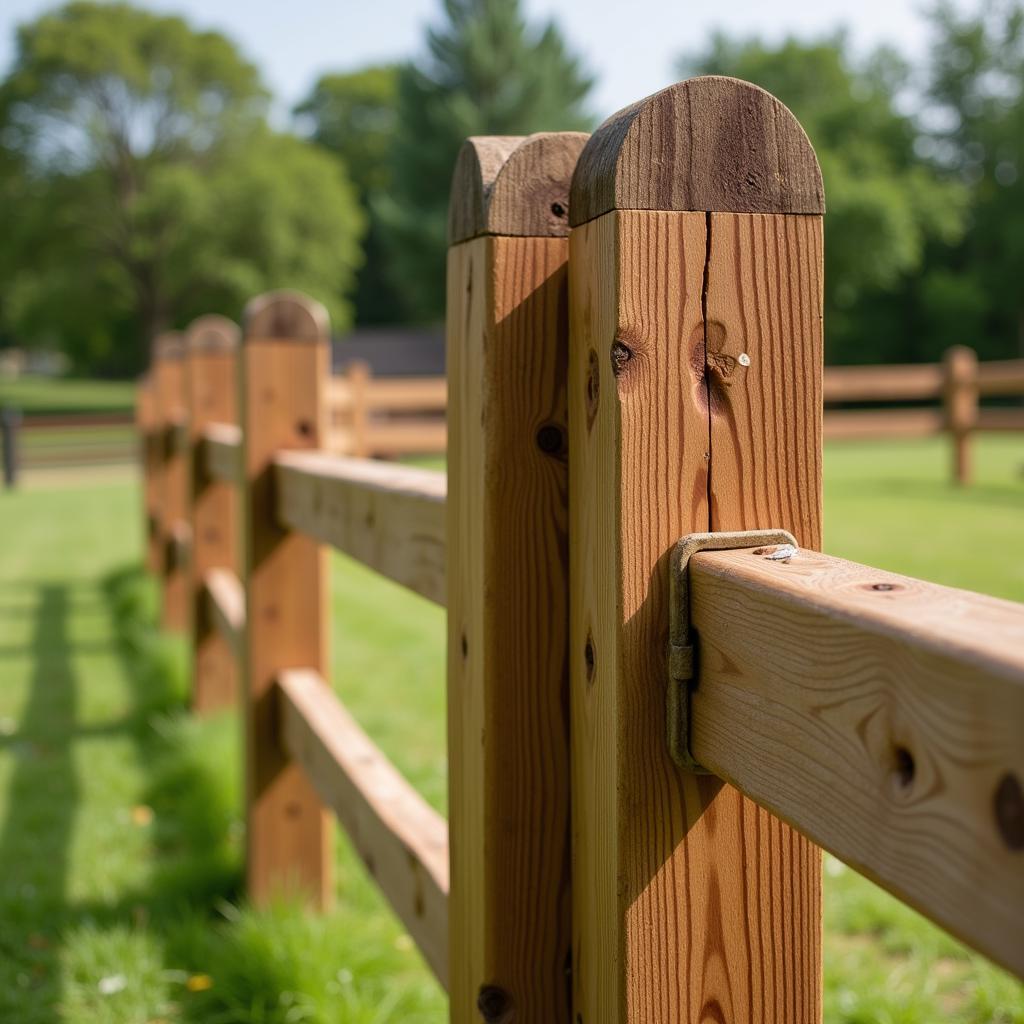Wooden Horse Fencing offers a classic and aesthetically pleasing way to contain and protect your equine companions. From sturdy post and rail designs to more intricate split rail options, understanding the nuances of wooden horse fencing is crucial for making the right choice for your property. This guide will delve into the various aspects of wooden horse fencing, helping you navigate the options and make an informed decision.
 Post and Rail Wooden Horse Fencing
Post and Rail Wooden Horse Fencing
Whether you’re establishing a new pasture or upgrading an existing enclosure, choosing the right fencing is paramount. Wooden fencing offers several advantages, including its natural look, relative ease of installation, and affordability compared to some other options like vinyl or composite. However, wood also requires regular maintenance to ensure its longevity and effectiveness. Let’s explore the key considerations for selecting and maintaining your wooden horse fence.
Types of Wooden Horse Fencing
Post and Rail Fencing
Post and rail fencing is a popular choice, known for its strength and simplicity. It typically consists of sturdy wooden posts set at regular intervals with two or three horizontal rails. This design provides excellent visibility and a clean, traditional look. It’s a good choice for containing horses securely while allowing them to see their surroundings. diamond mesh horse fence offers a different style of containment.
Split Rail Fencing
Split rail fencing, often referred to as “zig-zag” fencing, offers a more rustic aesthetic. Constructed from split logs, it creates a natural and visually appealing boundary. While not as robust as post and rail, it can be a suitable choice for less demanding containment needs, such as defining property lines or enclosing less active horses. Consider a round horse corral for a more specialized enclosure.
Key Considerations for Wooden Horse Fencing
Wood Species
The type of wood used significantly impacts the fence’s durability and lifespan. Hardwoods like oak and cedar are naturally resistant to rot and insect damage, making them ideal choices for horse fencing. Pressure-treated pine is a more affordable option but requires more frequent maintenance. If you’re considering other options for your barn, take a look at prefabricated horse stalls.
Height and Spacing
The height of your fence should be appropriate for the size and temperament of your horses. Generally, a height of 4.5 to 5 feet is recommended. Rail spacing should be close enough to prevent horses from getting their legs caught.
Maintenance
Wooden fences require regular maintenance to protect them from the elements and prolong their lifespan. This includes painting or staining the wood to prevent rot and insect damage, as well as checking for and repairing any broken rails or loose posts.
“Choosing the right wood is the first step to a long-lasting fence. Opt for hardwoods like oak or cedar for superior durability,” advises John Miller, a seasoned equine facility designer.
Installing Wooden Horse Fencing
Proper installation is crucial for a secure and stable fence. Ensure posts are set deep enough to withstand pressure and spaced appropriately for the chosen rail configuration. Consider what things you need for horses beyond fencing.
“A well-built fence is an investment in your horses’ safety and the overall aesthetics of your property,” says Sarah Johnson, an experienced horse farm manager. “Don’t underestimate the importance of proper installation.” Check out various horse fence gates to complete your fencing project.
In conclusion, wooden horse fencing offers a timeless and functional solution for containing your horses. By carefully considering the wood type, design, and maintenance requirements, you can create a safe and beautiful enclosure that will last for years. Remember to choose high-quality materials and prioritize proper installation for optimal performance and longevity.
FAQ
- What is the best wood for horse fencing?
- How high should a wooden horse fence be?
- How do I maintain my wooden horse fence?
- What is the difference between post and rail and split rail fencing?
- How much does wooden horse fencing cost?
- How do I install wooden horse fencing?
- Where can I find reliable installers for wooden horse fencing?
Common Scenarios
-
Scenario: A horse owner wants to create a safe and aesthetically pleasing pasture for their horses.
-
Solution: Wooden horse fencing, specifically post and rail, offers a classic and secure solution.
-
Scenario: A property owner wants to define their property lines with a rustic-looking fence.
-
Solution: Split rail fencing provides a natural and visually appealing boundary.
Further Reading
For more information on horse care and fencing options, visit our website for articles on related topics.
Need help with your wooden horse fencing project? Contact us! Phone: 0772127271, Email: [email protected] or visit us at QGM2+WX2, Vị Trung, Vị Thuỷ, Hậu Giang, Việt Nam. We have a 24/7 customer service team.